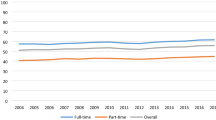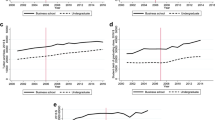Abstract
For decades, educators and policy makers have decried low graduation rates at US colleges, advocating policies and making investments to improve graduation. We analyze a decade of Integrated Postsecondary Education Data System (IPEDS) data for four-year colleges to investigate how much institutions have improved their graduation rates from 2008 through 2018, once controlling for institutional and student-body characteristics. We find substantial improvement to graduation rates at public colleges, modest improvement at private not-for-profits, and a decline in graduation at the for-profit sector. We then investigate whether improvements to graduate rates are associated with variation in student-body composition, selectivity, and institutional expenditures, using pooled cross-sectional, Prais–Winsten, and college fixed-effect models. We find that most between-college variation in graduation rates over time reflects variation in the composition of a college’s student body and in instructional expenditures. Our Bending the Curve metric utilizes the cross-sectional models to calculate predicted graduation rates for each college and determines how much they exceeded or failed to meet expectations. Unadjusted graduation measures, such as IPEDS’ rates that fail to adjust for these compositional factors, are poor indicators of institutional effectiveness and can mislead stakeholders who use them as an indicator of college performance.

Similar content being viewed by others
Notes
Roughly 13% of the institutions in our sample do not require test scores. Additionally, there is a high correlation between requiring test scores and the performance in these tests with our institutional selectivity variable. As such, to not lose information particularly on lower ranked institutions and following recent research we chose to include only institutional selectivity in the final models.
We also performed tests using 6-year lagged predictors of graduation rates. For example, 2018 graduation rates were predicted using 2013 predictors. Our models remained very similar and our meaningful conclusions did not change. As such, we opted to use contemporaneous predictors that would allow us to increase our long-term analysis.
References
Archibald, R.B. and Feldman, D.H. (2008) Graduation rates and accountability: Regressions versus production frontiers. Research in Higher Education 49: 80–100. https://doi.org/10.1007/s11162-007-9063-6
Astin, A.W. (1993). ‘College retention rates are often misleading.’ The Chronicle of Higher Education, 22 September, pg. A48.
Astin, A.W. (1997). ‘How “good” is your institution’s retention rate?’ Research in Higher Education 38: 647–658. https://www.jstor.org/stable/40196281
Azen, R. and Budescu, D.V. (2006) Comparing predictors in multivariate regression models: An extension of dominance analysis. Journal of Educational and Behavioral Statistics 31: 157–180. https://doi.org/10.3102/10769986031002157
Bailey, B.L. (2006) Let the data talk: Developing models to explain IPEDS graduation rates. New Directions for Institutional Research 131: 101–115. https://doi.org/10.1002/ir.190
Banta, T.W., Rudolph, L.B., Van Dyke, J. and Fisher, H.S. (1996) Performance funding comes of age in Tennessee. The Journal of Higher Education 67: 23–45. https://doi.org/10.1023/A:1018716627932
Barron’s Educational Series, College Division (Ed.). (2008). Barron’s profile of American colleges 2009. Barron’s Educational Series, Inc.
Baum, S., and Scott-Clayton, J. (2013). ‘Redesigning the Pell Grant program for the twenty-first century.’ The Hamilton Project (Discussion Paper 2013-04). Brookings Institute. https://vtechworks.lib.vt.edu/bitstream/handle/10919/90858/RedesigningPellGrantProgram.pdf?sequence=1
Boland, W.C. (2020) Performance funding and Historically Black Colleges and Universities: An assessment of financial incentives and Baccalaureate degree production. Educational Policy 34(4): 644–673. https://doi.org/10.1177/0895904818802118
Budescu, D.V. (1993) Dominance analysis: A new approach to the problem of relative importance of predictors in multiple regression. Psychological Bulletin 114: 542–551. https://doi.org/10.1037/0033-2909.114.3.542
Chetty, R., Friedman, J.N., Saez, E., Turner, N. and Yagan, D. (2020) Income segregation and intergenerational mobility across colleges in the United States. Quarterly Journal of Economics 135: 1567–1633. https://doi.org/10.1093/qje/qjaa005
Chronicle of Higher Education. (2019). ‘Colleges with the best and worst 6-year graduation rates, 2017.’ The Chronicle of Higher Education, 7 April. https://www.chronicle.com/article/Colleges-With-the-Best-and/246069
Cintron, M. (2019). An Analysis of Performance-Based Funding Measures in Florida (Publication No. 4041). [Doctoral dissertation, Florida International University]. FIU Electronic Theses and Dissertations. https://digitalcommons.fiu.edu/etd/4041
Clotfelter, C.T., Ladd, H.F., Muschkin, C.G., and Vigdor, J.L. (2010). ‘Success in community college: Do institutions differ?’ Research in Higher Education 54: 805–824. https://www.jstor.org/stable/24571746
Complete College America. (2020). Strategic plan 2019–2022. https://completecollege.org/wp-content/uploads/2019/06/CCA_3-Yr-Strategic-Plan_2019_one-pager.pdf
Cook, B., and Pullaro, N. (2010). College graduation rates: Behind the numbers. American Council on Education. https://www.acenet.edu/Documents/College-Graduation-Rates-Behind-the-Numbers.pdf
Dougherty, K., Jones, S., Lahr, H., Natow, R., Pheatt, L. and Reddy, V. (2016) Performance funding for higher education, Baltimore: Johns Hopkins University Press.
Elliott, K.C., Haynes, L., and Jones, T. (2021). Re-Imagining Outcomes-Based Funding: State-Level Handbook. The Education Trust. https://sheeo.org/wp-content/uploads/2021/05/OBF_HANDBOOK_FINAL_V9.pdf
Gándara, D. and Rutherford, A. (2018) Mitigating unintended impacts? The effects of premiums for underserved populations in performance-funding policies for higher education. Research in Higher Education 59(6): 681–703. https://doi.org/10.1007/s11162-017-9483-x
Gates Foundation, Bill & Melinda. (2020a). Post-Secondary Success: Strategy Overview. https://www.gatesfoundation.org/what-we-do/us-program/postsecondary-success
Hagood, L.P. (2019) The financial benefits and burdens of performance funding in higher education. Educational Evaluation and Policy Analysis 41: 189–213. https://doi.org/10.3102/0162373719837318
Hess, F.M., Schneider, M., Carey, K., and Kelly, A.P. (2009). Diplomas and Dropouts: Which Colleges Actually Graduate Their Students (And Which Don’t). Washington D.C.: American Enterprise Institute for Public Policy Research.
Hillman, N.W. and Corral, D. (2017) The equity implications of paying for performance in higher education. American Behavioral Scientist 61(14): 1757–1772. https://doi.org/10.1177/0002764217744834
Hillman, N.W., Tandberg, D.A. and Fryar, A.H. (2015) Evaluating the impacts of “new” performance funding in higher education. Educational Evaluation and Policy Analysis 37(4): 501–519. https://doi.org/10.3102/0162373714560224
Hillman, N.W., Tandberg, D.A. and Gross, J.P.K. (2014) Performance funding in higher education: Do financial incentives impact college completions? The Journal of Higher Education 85(6): 826–857. https://doi.org/10.1353/jhe.2014.0031
Horn, L., and Carroll, C. D. (2006). ‘Placing graduation rates in context: How 4-year college graduation rates vary with selectivity and the size of low-income enrollment.’ Postsecondary Education Descriptive Analysis Report (NCES 2007-161). U.S. Department of Education. https://files.eric.ed.gov/fulltext/ED494020.pdf
Huo, J., Nelson, M. and Stephens, J. (2008) Decommodification and activation in social democratic policy. Journal of European Social Policy 18(1): 5–20
Hurwitz, M. and Smith, J. (2018) ‘Student responsiveness to earnings data in the College Scorecard. Economic Inquiry 56(2): 1220–1243. https://doi.org/10.1111/ecin.12530
Institute for Higher Education Policy (IHEP). (2020). Degree completion. http://www.ihep.org/ihep-policy-priorities/degree-completion
Kelchen, R. (2018) Higher education accountability, Baltimore: Johns Hopkins University Press.
Kelchen, R. (2019) Exploring the relationship between performance-based funding design and underrepresented student enrollment at community colleges. Community College Review 47(4): 382–405. https://doi.org/10.1177/0091552119865611
Kelchen, R. and Stedrak, L.J. (2016) Does performance-based funding affect colleges’ financial priorities? Journal of Education Finance 41(3): 302–321. https://doi.org/10.1353/JEF.2016.0006
Kim, J. and Shim, W. (2019) What do rankings measure? The U.S. News rankings and student experience at liberal arts colleges. The Review of Higher Education 42(3): 933–964. https://doi.org/10.1353/rhe.2019.0025
Kurlaender, M., Carrell, S. and Jackson, J. (2016) The promises and pitfalls of measuring community college. RSF: the Russell Sage Foundation Journal of the Social Sciences 2: 174–190. https://doi.org/10.7758/rsf.2016.2.1.08
Li, A.Y. (2020) Performance funding policy impacts on STEM degree attainment. Educational Policy 34(2): 312–349. https://doi.org/10.1177/0895904818755455
Lumina Foundation. (2020b). Our priorities. luminafoundation.org/about/strategic-plan/
Meyer, K. and Rosinger, K.O. (2019) Applying behavioral insights to improve postsecondary education outcomes: A review of Obama Administration efforts and next steps under the Trump Administration. Journal of Policy Analysis and Management 38(2): 481–499. https://doi.org/10.1002/pam.22123
Morse, R., and Brooks, E. (2022). ‘How U.S. News calculated the 2022–2023 best college rankings.” U.S. News and World Report, 11 Sept. usnews.com/education/best-colleges/articles/how-us-news-calculated-the-rankings
Mortenson, T.G. (1997a) Actual versus predicted institutional graduation rates for 1100 colleges and universities. Postsecondary Education Opportunity 58: 1–24
Mortenson, T.G. (1997b) 5-year institutional graduation rates by degree level, control and academic selectivity: 1983 to 1997. Postsecondary Education Opportunity 73: 1–10
National Center for Education Statistics (NCES). (2020). About IPEDS. U.S. Department of Education. https://nces.ed.gov/ipeds/about-ipeds
Ortagus, J.C., Kelchin, R., Rosinger, K. and Voorhees, N. (2020) Performance-based funding in American higher education: A systematic synthesis of the intended and unintended consequences. Educational Evaluation and Policy Analysis 42(4): 520–550. https://doi.org/10.3102/0162373720953128
Prais, S.J., and Winsten, C.B. (1954). ‘Trend estimators and serial correlation.’ Cowles Commission Discussion Paper, Statistics No. 383. https://cowles.yale.edu/sites/default/files/files/pub/cdp/s-0383.pdf
Scott, M., Bailey, T., and Kienzl, G. (2006). ‘Relative success? Determinants of college graduation rates in public and private colleges in the U.S.’ Research in Higher Education 47: 249–279. https://www.jstor.org/stable/40197400
Student Right-to-Know and Campus Security Act of 1990, 20 U.S.C. § §1001-1092 (1990).
U.S. Department of Health Education and Welfare (US HEW). (1974). Second Newman Report: National Policy and Higher Education. Special Task Force to the Secretary of the US Department of Health, Education and Welfare. Cambridge: MIT Press.
Umbricht, M.R., Fernandez, F. and Ortagus, J.C. (2017) ‘An examination of the (un)intended consequences of performance funding in higher education. Educational Policy 31(5): 643–673. https://doi.org/10.1177/0895904815614398
Wade, N.L. (2019) Measuring, manipulating, and predicting student success: A 10-year assessment of Carnegie RI Doctoral Universities between 2004 and 2013. Journal of College Student Retention: Research, Theory, and Practice 21(2): 119–141. https://doi.org/10.1177/1521025119831456
Ward, J. and Ost, B. (2021) The effect of large-scale performance-based funding in higher education. Education Finance and Policy 16(1): 92–124. https://doi.org/10.1162/edfp_a_00300
Zhang, L. (2009) Does state funding affect graduation rates at public four-year colleges and universities? Educational Policy 23: 714–731. https://doi.org/10.1177/0895904808321270
Funding
This report is based on research funded in part by the Bill & Melinda Gates Foundation (Grant # OPP1159855) and Ascendium Education Solutions, formerly the Great Lakes Higher Education Guaranty Corporation (Grant # G-201704-15499). The findings and conclusions contained within are those of the authors and do not necessarily reflect positions or policies of the Bill & Melinda Gates Foundation, or Ascendium Education Solutions.
Author information
Authors and Affiliations
Corresponding author
Ethics declarations
Conflict of interest
On behalf of all authors, the corresponding author states that there is no conflict of interest.
Additional information
Publisher's Note
Springer Nature remains neutral with regard to jurisdictional claims in published maps and institutional affiliations.
Rights and permissions
Springer Nature or its licensor (e.g. a society or other partner) holds exclusive rights to this article under a publishing agreement with the author(s) or other rightsholder(s); author self-archiving of the accepted manuscript version of this article is solely governed by the terms of such publishing agreement and applicable law.
About this article
Cite this article
de Castro Galvao, J., Tucker, F. & Attewell, P. Bending the Curve: Institutional Factors Associated with Graduation Rates. High Educ Policy (2023). https://doi.org/10.1057/s41307-023-00304-5
Published:
DOI: https://doi.org/10.1057/s41307-023-00304-5




